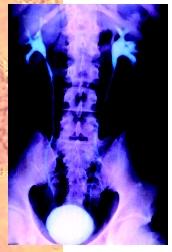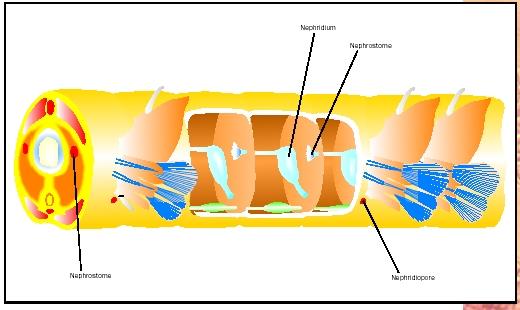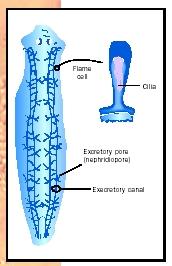Excretory Systems

Most animals require some system to excrete the waste products of metabolism from the body fluids. Kidneys are the major organs of the excretory systems of humans and other vertebrates, but several other kinds of excretory organs occur in other kinds of animals.
Functions and Principles
Besides metabolic wastes, kidneys and other excretory organs also eliminate excess water, ions , or other substances that are taken in with food. Moreover, although they are referred to as excretory systems, what they retain in the body fluids is just as important as what they excrete. They are best viewed as systems that maintain a constant, or homeostatic, composition of the body fluids.
Water and ions are among the important components of the body fluids that must be maintained homeostatically. Cells will shrink if placed in a fluid that has too high an ion concentration because water will be drawn out of the cell by osmosis . Cells will swell in a fluid that is too dilute because water will be drawn into them by osmosis. Maintaining a balance of water and ions—osmoregulation—is another major homeostatic function of the excretory organs of most animals.
With few exceptions, the osmoregulatory and excretory functions are combined in the same organ, which generally works in two stages. First the organ filters blood or another body fluid into a tubule. Then as the filtrate passes through the tubule, needed molecules are pumped out of it and back into the body fluid. At the same time, metabolic wastes and excess water and other molecules in the body fluids are pumped into the filtrate by active transport. The resulting fluid, called urine, is eliminated through the open end of the tubule outside the body.
Variety in the Animal Kingdom
In flatworms and a few kinds of invertebrates the excretory/osmoregulatory organ is a protonephridium. By definition, the protonephridium has a tubule that is open only at the end leading outside the body. The other end of the protonephridium has cilia or a flagellum that draws body fluid in to form


Insects, crustaceans, spiders, and other arthropods have different types of excretory/osmoregulatory organs, but they too operate by filtration and active transport. In insects and spiders the main organs are Malpighian (pronounced mal-PIG-ee-yan) tubules, which are attached to the gut. For these terrestrial animals the problem is to conserve water, rather than eliminate it. Water, containing metabolic wastes and excess ions, is filtered into the Malpighian tubules and then joins the feces in the hind part of the gut. As the feces passes through the rectum, the water is pumped back into the body fluid.
In vertebrates the excretory/osmoregulatory organ is the kidney. The vertebrate kidney contains thousands or even millions of tubules, called nephrons , each one of which uses the same principles of filtration and active transport. One difference between kidneys and most other excretory/osmoregulatory organs is that kidneys filter blood rather than some other body fluid. Nephrons form a filtrate consisting of water, nutrients, ions, and other components of blood except cells and very large molecules. As the filtrate passes along the nephron tubule, nutrients, water, and other needed molecules are transported back into the bloodstream. Ions, metabolic wastes, and other excess molecules go into the resulting fluid. Finally, more water is removed from the fluid, transforming it into urine.
Exceptions
There are two exceptions to the generalization that excretion and osmoregulation are performed by the same systems. The first exception occurs in animals that spend their entire lives in the fairly constant environment of the ocean. For them, osmoregulation is not needed because the balance of water and ions in the oceans is osmotically suitable for cells. (This is not surprising, considering that life most likely evolved in the oceans.) A starfish, for example, does not have or normally need an osmoregulatory system. If a starfish is placed in water with a higher concentration of salts than in the ocean, however, water will be drawn out of it by osmosis, and it will shrink. Conversely, if the starfish is placed in fresh water, it will swell and burst as water is drawn into the more concentrated body fluids.
The second exception to the rule that osmoregulation and excretion are performed by the same system occurs in some sponges and other relatively simple animals that live in fresh water. These animals osmoregulate by collecting excess water in each cell within a chamber called the contractile vacuole. When full, the contractile vacuole contracts and expels the water through the plasma membrane of the cell. The contractile vacuole is also called the water expulsion vesicle.
SEE ALSO Insect ; Kidney ; Osmoregulation ; Porifera
C. Leon Harris
Bibliography
Hickman, Cleveland P., Jr., Larry S. Roberts, and Allan Larson. "Homeostasis." In Integrated Principles of Zoology, 11th ed. Boston: McGraw-Hill Higher Education, 2001.
Saladin, Kenneth S. "The Urinary System" and "Water, Electrolyte, and Acid-Base Balance." In Anatomy and Physiology. Boston: McGraw-Hill Higher Education, 2001.
